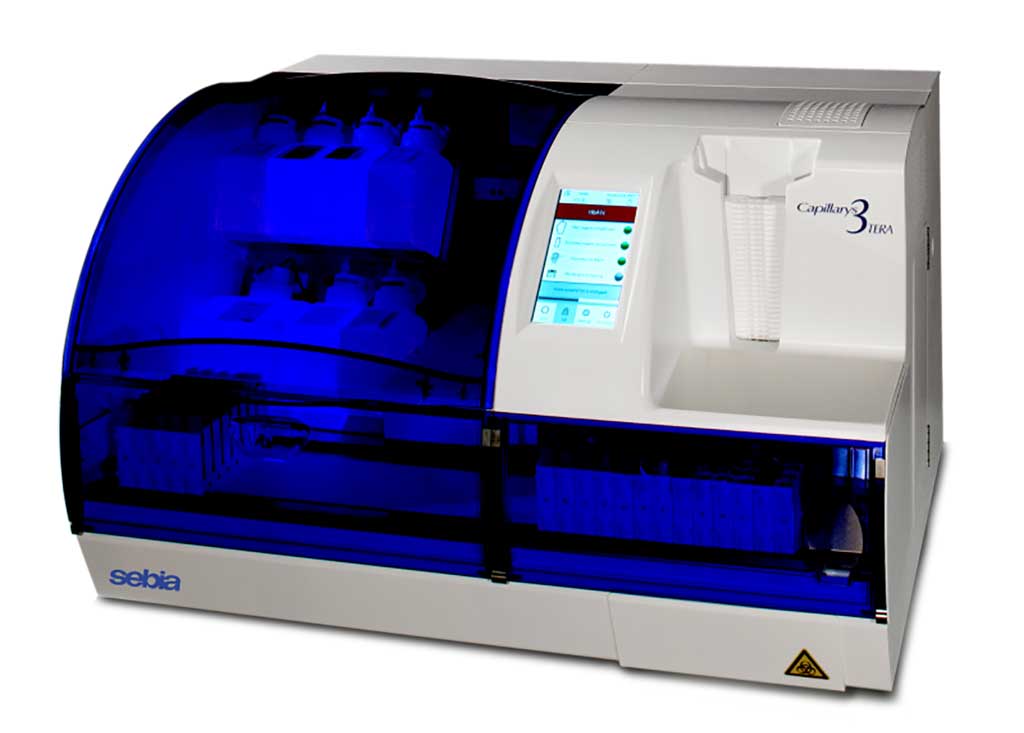Gel and Capillary Electrophoresis Compared for Human Proteins
By LabMedica International staff writers
Posted on 12 May 2021
The electrophoresis of serum proteins remains a laboratory cornerstone for the diagnosis and monitoring of patients with plasma cell disorders, such as monoclonal gammopathy of undetermined significance, multiple myeloma, Waldenström macroglobulinemia, and AL amyloidosis.Posted on 12 May 2021
Gel electrophoresis remains the method used by most clinical laboratories in the USA. However usage of gel electrophoresis is gradually decreasing while that of capillary electrophoresis is increasing. More recently, analysis of liquid media by capillary electrophoresis was developed and applied to the analysis of serum proteins for clinical purposes.

Image: The Capillarys 3 TERA is an automated analyzer based on capillary zone electrophoresis and UV detection for the quantitative analysis of Hba1c, proteins (serum and urine), immunotyping (serum and urine), and carbohydrate deficient transferrin (Photo courtesy of Sebia)
Laboratory Immunologists at The Johns Hopkins School of Medicine (Baltimore, MD, USA) tested all serum samples analyzed by the immunology laboratory over the course of eight days for routine clinical purposes during the months of October and November 2019, totaling 304 sera. There were 160 females (62 ± 16 years, range 19 -95) and 144 males (65 ± 14 years, range 23-97), with no significant difference in age according to sex.
Sera were first ran using the system currently in use, which consists of a thin-layer agarose gel, HYDRAGEL 30 Protein (E) (Sebia, Lisses, France) and the Sebia Hydrasys 2 semi-automated analyzer. Sera were then assayed on the Sebia Capillarys III TERA automated analyzer using CAPI 3 Protein (E) reagents. Serum immunofixation electrophoresis (SIFE) was performed in 214 of the total 304 sera because already ordered by the provider for most cases. Sera were pre-diluted according to the immunoglobulin G, A, and M concentrations, and then ran on the immunofixation system currently in use, which consists of a thin-layer agarose gel (HYDRAGEL IF 2/4, from Sebia) and the Hydrasys 2 semi-automated analyzer.
The scientists reported that Gel and capillary estimated the concentration of albumin, gamma region, and M-spikes nearly perfectly, and that of beta, alpha-2, and alpha-1 regions with excellent correlation. The two systems classified concordantly 268 of 304 sera (88% agreement) as having no, one, or two M-spikes, but differed in the remaining 36 sera (12%). Gel electrophoresis correctly identified M-spikes in 82 of 112 sera that were shown to have monoclonal band(s) by immunofixation (73% sensitivity), and correctly did not reveal M-spikes in 97/102 sera that had no immunofixation bands (95% specificity). Capillary achieved slightly higher sensitivity (85/112, 76%) and slightly lower specificity (94/102, 92%), but the two areas under the ROC curves were nearly identical at 0.84.
The authors concluded that Gel and capillary electrophoresis systems perform similarly to estimate the concentration of serum protein fractions and detect M-spikes. The Capillarys system has the disadvantages of a higher equipment cost and requiring a greater sample volume. On the other hand, Capillarys requires less involvement of laboratory technicians, offers a faster turn-around time, identifies the specimens they are being analyzed, does not depend upon the chemicals needed to stain and destain the gels, and is more amenable to remote reporting. The study was published on April 29, 2021 in the journal Practical Laboratory Medicine.
Related Links:
The Johns Hopkins School of Medicine
Sebia




 assay.jpg)








